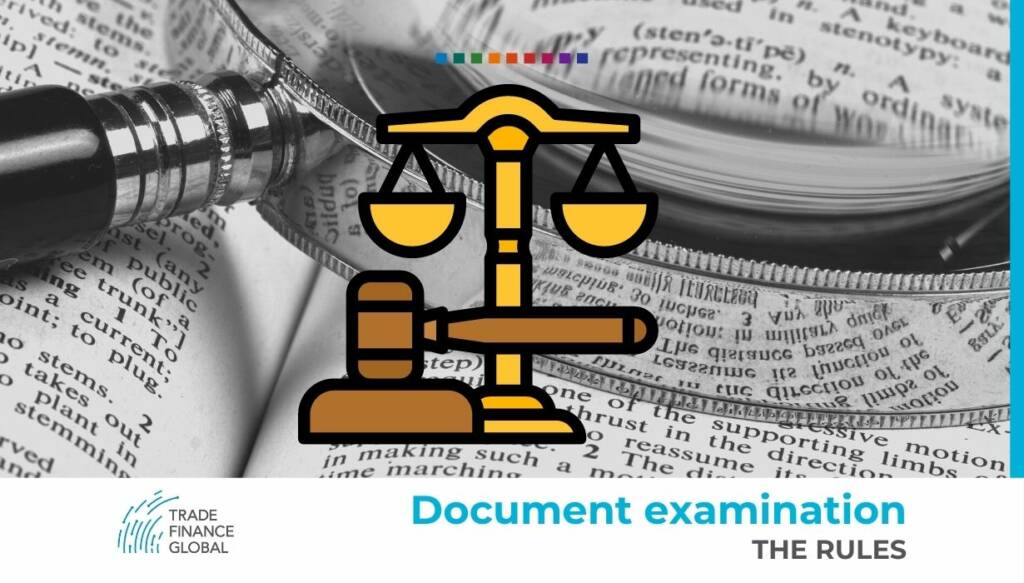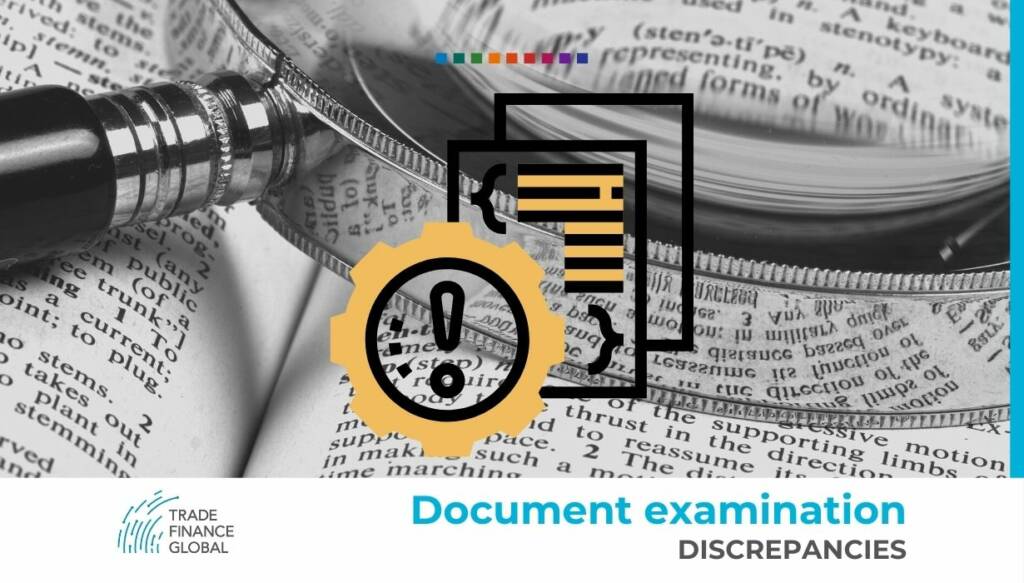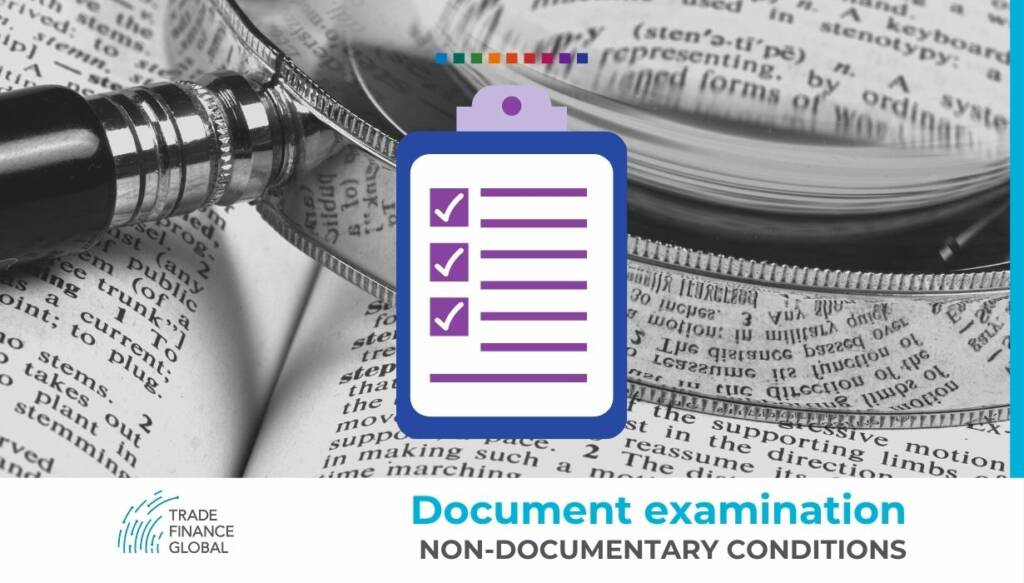Documents play a significant role in international trade finance transactions. The number of the required documents in a transaction will vary depending on various factors, including, the buyer and seller, the sales contract, the importing and exporting country, the nature of the goods, or services and transportation of the goods.
These required documents will usually be listed in the contract between buyer and seller, and at later stages in a trade, may be stipulated as a requirement in exchange for payment. Some of these documents may be needed to meet government requirements, while others are required for commercial purposes. The correct documentation will avoid any delay in delivering the goods to the buyer, while at the same time ensuring a timely payment to the seller.
In this article, TFG’s ITPP member, Osama Ibrahem explores some of the frequent challenges document examiners face in international trade. What do the rules say, and what should we have a more pragmatic approach to data conflict and unwarranted discrepancies in international trade?
An introduction to trade documents
The documents involved in international trade could be divided into five categories: commercial, financial, official, transport and insurance documents. Each of the documents has a specific function and acts as certain evidence within the transactional process. For example, some transport documents, such as bills of lading, act as evidence of the contract of carriage of the goods by sea, while also acting as a document of title, meaning the possession of the document is required to take physical possession of the goods.
During the negotiation of the sales contract, the buyer and seller should agree on the specific elements of how they will trade and how the seller will get paid for those goods, services or performance i.e., which method of settlement, it could be one of the following, open account, documentary collection, documentary credit and payment in advance, the chosen method depends largely on the relationship between the parties, the countries involved, financing and working capital and movement of goods and documents.
The seller might look to secure a payment made on open account terms, or by documentary collection, also the buyer might look for the same security in a payment in advance. This security could be provided by the issuance of a demand guarantee or standby letter of credit in their favour and can be claimed in the event of a failure in the transaction.
A commercial letter of credit, standby letter of credit and demand guarantee all represent irrevocable undertakings, usually by banks, against specified documents in the undertaking. These documents must comply with the terms and conditions of the undertaking so that payment effected properly to the beneficiary. The document examiner must decide whether to take up or refuse the documents presented and this decision reached after the process of examination.
One of the difficulties surrounding the examination of documents is determining the standard by which compliance should be measured. The examination process may have two approaches: strict compliance and substantial compliance. sometimes said that the document examiner should apply the concept of strict compliance when examining a presentation; however, strict compliance is a legal principle and is not expressly stated in any of the ICC publications UCP 600, URDG 758 or ISP98.
The document examiner in the strict compliance approach will identify the minor and even non-commercial discrepancies and if the documents do not strictly conform to the undertaking, their presentation is non-complying, even if the non-compliance is of no practical significance.
On the other hand, in the substantial compliance approach, the document examiner will identify the discrepancies that have a commercial consequence and a practical significance.
These two approaches may lead to a different result on the compliance of the presentation. The ICC discourages the use of immaterial or insignificant discrepancies as a way to avoid the bank’s obligation and gain a commercial advantage by charging discrepancies fees and this presented under a significant numerous of ICC Opinions and DOCDEX decisions. The principle of strict compliance discussed by David Meynell through the ICC paper Document No. 470/1261.
One of the main reasons behind the unwarranted discrepancies and refusals is the misuse and misinterpretation of “Inconsistency between Documents” and “Conflict of data”. The ICC publications UCP 600, URDG 758 and ISP98 refer to these terms.
So, what do the rules state?

UCP 600
The Uniform Customs and Practice for Documentary Credits is a set of rules governing documentary credits (letter of credit, commercial letter of credit, credit) agreed by the International Chamber of Commerce ICC Publication No.600.
Sub-article 14(d) states:
“Data in a document, when read in context with the credit, the document itself and international standard banking practice, need not be identical to, but must not conflict with, data in that document, any other stipulated document or the credit.”
A brief history of sub-article 14 (d)
Matters relating to consistency between documents first appeared in UCP 290 and stayed through UCP 400 and UCP 500 with some changes in the wording. UCP 600 substituted the term “not conflict” for that of “inconsistent” in sub-article 14 (d) as all the data in the required document when read in context with the credit, the document itself and international standard banking practice, does not need to be identical, but must not conflict with data in the same document, any other stipulated document or the credit.
This change is an attempt by the drafting group to lead to a reduction of the discrepancies and to a narrower and more preferable concept than one stating “documents which appear on their face to be inconsistent with one another” and would require document examiners to make a decision based on the compliance of the data itself as mere differences do not make for a conflict, but rather represent a different way for expressing the data.

The term “Conflict”
Under UCP 600 sub-article 14 (d) any data in a document can be compared to any other data in the document itself, other required documents, or the credit for conflict whether this data is required or not by the credit or the UCP. By inserting data on a document, the beneficiary is inviting the document examiner to check this data, so that a beneficiary should consider avoiding inserting excessive details when preparing their documents to avoid creating conflict.
ISBP 745 provides several examples for inserting additional data and will not be regarded as a conflict under UCP 600 sub-article 14 (d). ISBP 745 is the latest version of International Standard Banking Practice for the examination of documents under UCP 600. It serves as an aid to a beneficiary of a documentary credit in its creation and presentation of documents to banks. It also works as a checklist for document examiners to follow in the examination process under documentary credit. These examples could be found under paragraphs A33, A34, C5 and D18 (a).
The term “in context”
Sub-article 14 (d) refers to the term “in context”, the document examiner should first read the data in a document in context with the credit. They should then read the data in the context of the document itself and understand the function, purpose and structure of the document. Finally, they should read the data in a document in the context of the international standard banking practice, some of which is contained in the ISBP, ICC Publication 745.
ISBP 745 provides several examples to explain this point one of them expressed under paragraph L5 quote:
“Consignee information, when shown, is not to conflict with the consignee information in the transport document. However, when a credit requires a transport document to be issued “to order”, “to the order of shipper”, “to order of issuing bank”, “to order of nominated bank (or negotiating bank)” or “consigned to issuing bank”, a certificate of origin may show the consignee as any entity named in the credit except the beneficiary. When a credit has been transferred, the first beneficiary may be stated to be the consignee.”
The Commentary on UCP 600 explains this point as follows:
“The consignee may well be a bank that takes an interest in the goods as a security for its financing or is indicated as consignee to prevent the applicant from claiming the goods without presentation of an original bill of lading. The consignee stated in the certificate of origin is there for customs purposes, whereas the consignee in the bill of lading refers to the function of the document as a document of title. Both parties are named “consignee” but serve different purposes for different addressees in the documents.”
Also, it is worth mentioning the ICC opinion R805 / TA758. ICC Opinions is one of the ICC services, they aim to encourage uniformity of practice in a field where individual document checkers often differ in the way that they approach documents that they have to review. This way they can prevent the development of disputes that would otherwise lead to court action. It addresses a query regarding possible inconsistencies in shipment date between a bill of lading, which showed a shipped on board date: 14 SEP 2011 and packing list shows shipping date 13.09.2011.
The analysis states:
“Reference in a packing list to “shipping date” does not necessarily relate to the date the goods were loaded on board the vessel at the port of loading as stated on the bill of lading. It can be in respect of the date of shipment (shipping) from the premises of the exporter, or the date of taking in charge by the carrier at the place of receipt. For these reasons, reference to shipping date in the packing list is not seen as a conflict of data.”
The above analysis is relevant to a similar issue addressed in DOCDEX Decision No. 319. The Documentary Dispute Resolution Expertise is a dispute resolution mechanism specifically designed to address trade finance concerns also Opinion R678 under UCP 500 discussed a query regarding possible inconsistency in a bill of lading dated 29 Jan. whilst inspection certificate stating loading 27 28 Jan. The conclusion states:
“Using the dates mentioned in the query, a charter party bill of lading that bears a pre-printed wording to the effect that the goods are on board the vessel on 29 January 2007, or bears an on board notation that is dated 29 January 2007, is not inconsistent with an inspection certificate stating that the loading period was 27 – 28 January 2007.”
As recognised from the references above the data in a document and all the required documents must be read as a whole and this may affect the interpretation of data.
The term “need not be identical”
Sub-article 14 (d) provides that data not required to be duplicated or to be a mirror image unless the credit otherwise provides, there is no requirement under UCP 600 for data replication.
The level of the data compliance is varying between what is required in Sub-article 18 (c) and Sub-article 14 (e) for the description of the goods, services or performance in a commercial invoice and other documents. In the commercial invoice the description to correspond with what stated in the credit while for other documents a lower level of data compliance is required as the description may be in general terms not conflicting with the credit.
The description of the goods in the commercial invoice is significantly important, which is why Sub-article 18 (c) requires to describe the goods, services, or performances to correspond with the credit.
The distinction in the level of data compliance is based on the nature and commercial function of the document, for example, the transport documents are more focussed on how, when and where the goods will be transported and the terms of the contract of the carriage, rather than the description of goods. ISBP 745 paragraphs A23, C3 and D30 provide several examples for how the data need not be identical.
Popular alleged discrepancies

1. Misspellings or typing errors
The issue of typing errors were addressed under ISBP 745 paragraph A23 quote:
“A misspelling or typing error that does not affect the meaning of a word or the sentence in which it occurs does not make a document discrepant. For example, a description of the goods shown as “mashine” instead of “machine”, “fountan pen” instead of “fountain pen” or “modle” instead of “model” would not be regarded as a conflict of data under UCP 600 sub-article 14 (d). However, a description shown as, for example, “model 123” instead of “model 321” will be regarded as a conflict of data under that sub-article.”
Additionally, there are numerous of opinions from the ICC relating to typing errors and whether the error in the question affects the meaning of a word or a sentence such as R209, R408, R442, R444, R559, R627, R698, R692, R701, R757, R808, R815, R871, R890 and R908 also the following DOCDEX decisions discuss the same issue Decisions No. 205, 221, 247, 249, 290 and 351
A23, the ICC opinions and the DOCDEX decisions has a growing consensus that mere occurrence of a typing error is not a reason for refusal and stresses that the meaning of the word or the sentence in question must be clear and could not be understood to mean something else in which it occurs in such a way that it would cause a discrepancy (e.g., creates a conflict in data), opinion R871 states:
“When a misspelling or typographical error exists, document examiners are expected to read it in context with: (i) the document on which it appears; (ii) the other required documents and determine whether the error causes a conflict as noted in UCP 600 sub-article 14 (d), and (iii) whether the error otherwise affects the meaning of the word(s).”
2. Wrong or missing letter of credit numbers
Another alleged discrepancy usually raised is missing, misquoting, mistyping, or wrong letter of credit numbers, this type of issue has been addressed in numerous of ICC Opinions such R289, R578, R635, R811, R852, R888 and DOCDEX decision No.329.
The recent opinion R888 provides an exception for mentioning the credit number on the documents as follows:
“The exception to this position is where it is a requirement of the importing country that the letter of credit number be stated on one or more documents. In such circumstances, the letter of credit should clearly indicate that this is the reason for the number to be shown on that or those documents.’’
URDG 758
The Uniform Rules for Demand Guarantees is a set of rules governing demand guarantees agreed by the International Chamber of Commerce ICC Publication No.758.
Sub-article 19(b) states:
“Data in a document required by the guarantee shall be examined in context with that document, the guarantee and these rules. Data need not be identical to, but shall not conflict with, data in that document, any other required document or the guarantee.”
Subarticle 19 (b) reflects the provision under UCP 600 sub-article 14 (d), similar to UCP 600 the term “not conflict” is new to URDG 758 and substituted for that of “inconsistent” as an attempt to lead to a reduction of discrepancies.
The provision reflects that data in the presented document must not conflict with other documents in the presentation or the guarantee. Differences do not automatically make a document discrepant the data in a document and all the specified documents must be read as a whole.
ISP98
The International Standby Practices ICC Publication No.590 is similar to UCP for commercial letters of credit reflects generally accepted practice, custom and usage specifically for standby letters of credit and provides a more relevant framework for a standby letter of credit.
Rule 4.3 states:
“An issuer or nominated person is required to examine documents for inconsistency with each other only to the extent provided in the standby.”
The principle in ISP98 rule 4.3 differs significantly from UCP 600 sub-article 14 (d), the rule affirms that the only consistency at issue in examining documents under a standby is concerning what is stated in the standby itself.
Of course, the case is different from the commercial letter of credit practice. In commercial letters of credit, the documents relate to a transaction in goods or services for which payment is demanded in connection with the performance of the underlying transaction. UCP 500 sub-article 13(a) (Standard for Examination of Documents) provided an examination for inconsistency and to refuse if there was an inconsistency, this concept misused due to a misinterpretation and it led to a significant number of discrepancies. To address these difficulties UCP 600 substituted the term “not conflict” for that of “inconsistent” and requires all the stipulated documents must not conflict with one another.
Each document must comply with the terms and conditions of the standby. Examination of the documents against one another is not required. The documents may be related to different obligations under the same or different transactions and due to the use of the standby in connection with a drawing in the event of a default, it is expected to be an inconsistency between documents with each other.
If a consistency between documents is required the standby must so state what is required so that the beneficiary is also aware and there is a basis for determination of compliance.
Conflict of data with non-documentary conditions

The examination process is based only upon the documents presented in this respect, it is important to note that poor drafting may lead to significant problems, drafting clauses that have a non-documentary nature should be avoided.
A non documentary condition relates to a fact which is not associated with a document to be presented. Document examiners cannot be expected to know or check facts which are not covered by a document to evidence compliance with the condition.
Although, in general, non-documentary conditions may be disregarded, they remain to be questioned for non-conflict, the required documents cannot contain data that conflicts with the guarantee’s conditions this also applies to non-documentary, this position clearly stated in article 7 from URDG 758 quote:
“A guarantee should not contain a condition other than a date or the lapse of a period without specifying a document to indicate compliance with that condition. If the guarantee does not specify any such document and the fulfilment of the condition cannot be determined from the guarantor’s own records or from an index specified in the guarantee, then the guarantor will deem such condition as not stated and will disregard it except for the purpose of determining whether data that may appear in a document specified in and presented under the guarantee do not conflict with data in the guarantee.”
For example, where the non-documentary condition refers to a required origin for the goods and the invoice presented shows a different origin, the presentation is not considered to be complying.
The position under UCP 600 sub-article 14 (h) is that if a letter of credit stipulates a condition without indicating the document required for compliance, the document examiner should simply treat the condition as if it did not exist and disregard it, the sub-article does not require them to check this condition for conflict.
Quote:
“If a credit contains a condition without stipulating the document to indicate compliance with the condition, banks will deem such condition as not stated and will disregard it.”
On the contrary, the commentary on UCP 600 states:
“non documentary conditions will still be subject to review under sub-article 14 (d) to ensure that any data is not conflicting”
Also, R631 / TA644rev states:
“The view of the Banking Commission is that sub-article 14 (h) is not absolute and is qualified by the content of sub-article 14 (d).”
And, lastly, ISBP 745 paragraph A26 states:
“When a credit contains a condition without stipulating a document to indicate compliance therewith (“non-documentary condition”), compliance with such condition need not be evidenced on any stipulated document. However, data contained in a stipulated document are not to be in conflict with the non-documentary condition. For example, when a credit indicates “packing in wooden cases” without indicating that such data is to appear on any stipulated document, a statement in any stipulated document indicating a different type of packing is considered to be a conflict of data.”
To avoid this confusion, the issue of non-documentary condition can be easily resolved by the instructing party or applicant and issuing bank, issuer, counter guarantor or guarantor by ensuring that any stated term or condition is clearly linked to a stipulated document.
The beneficiary should be wise when the data is considered to be non-documentary; it should be ignored until the point where that data is included within another stipulated document, that it is not inserted in a manner that will cause conflict, or the beneficiary should seek a suitable amendment.
ISP98 rule 4.11 reflects the provision in UCP 600 sub-article 14 (h) to disregard non documentary conditions and clarifies that they should do so whether or not such conditions relate to the compliance of the demand or standby issuance, amendment or termination.
Conclusion
The ICC approach is softening the principle of strict compliance. This approach is highlighted in numerous attempts to keep trade flowing smoothly and to reduce the payment refusal. At first, the document examination process may not seem easy to approach, and while the document examiner should be familiar with the content, function and purpose of the document, he/she is not required to be an expert in each and every document and its content. Rationality and common sense should be applied above all else, as the examination of documents is not a robotic or rigid process.




























